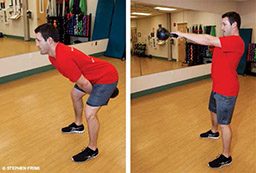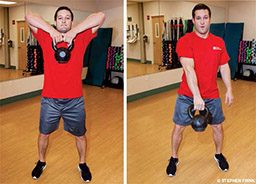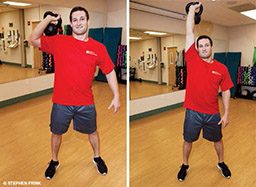The best exercise program is one that becomes and remains part of your daily life: Continued motivation is the key to success. Motivational plateaus can undermine the long-term effectiveness of any training program, and circuit training with kettlebells is a great way to add excitement to your routine.
Why Circuit Training with Kettlebells?
Circuit training incorporates multiple fitness goals into a single workout, and it’s one of the most effective methods of increasing muscular and cardiovascular endurance and maintaining strength. Kettlebells were developed in Russia for use in sport and were used by the Soviets to condition their soldiers. Adding kettlebells to circuit training further enhances strength and endurance.
Strength and power: Kettlebells improve strength and power throughout your body because the exercises involve coordination of multiple large muscle groups. Power is important for divers when entering and exiting the water and manipulating heavy equipment. Improving your power makes predive preparation easier, saving more energy for the dive.
Endurance: Kettlebell exercises are typically performed with many repetitions and little rest. The holistic and explosive nature of the exercises targets the cardiovascular system. The resulting improvements in the efficiency of your oxygen-delivery system will help you fin against strong currents and carry your gear down the dock or beach with greater ease.
Body composition: Circuit training quickly increases lean muscle mass while torching fat. Many aerobic exercises, such as running, contribute to a decrease in total weight (both fat and lean body mass). In other words, traditional aerobic training can cause loss of muscle along with fat (potentially lowering your metabolism). But due to the resistance involved, kettlebell circuit training promotes growth of lean muscle (which increases your metabolism) while simultaneously reducing body fat.
Time: The most common excuse for not exercising is a lack of time. Circuit training offers the best of both worlds — aerobic and resistance training — and can thus cut workout time in half.
Functional benefits: When was the last time you picked up your dive bag, your scuba tank or even your groceries in a perfect squatting position? Kettlebell training guides your muscles in a dynamic yet controlled manner; this mimics the way your muscles work in daily life.
Kettlebells make it easy to track your progress. Once exercises start to become too easy you can increase the weight, work unilaterally (on one side) or try combination movements (putting two or more exercises together). These new challenges can help keep your mind from wandering and your body from plateauing.
Kettlebell Basics
Due to the recent increase in popularity of kettlebells, you can purchase them at most sporting-goods stores. They can be found online as well — just make sure you don’t have to pay for shipping. A 10- to 25-pound kettlebell, which is a good starting range for most people, costs between $20 and $60. Lighter kettlebells cost less and promote early development of good form.
A Kettlebell Circuit
Start with a 10- to 25-pound kettlebell, depending on your age, gender and training level. The weight should feel light to start; proper form is vital to success.
Familiarize yourself with the following exercises by performing eight repetitions of each. Once you can complete eight reps with good form, progressively increase to 20 reps. When you can perform 20 reps, it is time to start slowly increasing the weight.
Perform 15 to 20 reps of each exercise in the circuit, resting for 15 seconds or less between exercises. Once you’ve completed all the exercises, rest for 60 to 90 seconds, and repeat the circuit. Do two to four circuits, depending on your fitness level and the time available.
Russian Swings

- Begin with the kettlebell between your feet. Bend your knees, push your butt back, keep your back straight, and pick up the kettlebell with both hands.
- Swing the kettlebell back between your legs.
- Forcefully reverse the direction of the kettlebell with a strong drive through the hips, and allow it to float in front of the body.
- Let the kettlebell swing back between your legs, and repeat.
Tip: Use explosive power from the legs to drive the hips forward and elevate the kettlebell until the bottom of it is perpendicular to the ground.
Challenge: Perform the swings with only one arm at a time.
High Pulls

- Place the kettlebell on the ground between your feet. Position your feet shoulder width apart or wider, set your hips back, and bend your knees while keeping your back straight and your chest out.
- Grab the kettlebell with both hands, and extend upward with your hips and knees. Simultaneously pull the kettlebell to shoulder height, keeping your elbows higher than your wrists.
- Return the kettlebell back to the hang position, but don’t let it touch the ground.
Tip: Focus your vision on something slightly higher than eye level.
Challenge: Instead of completing the exercise with the kettlebell in the hang position, return it to the ground at the end of each repetition.
Clean & Jerk

- Begin standing, holding the kettlebell in one hand between your legs. The back of your hand should face forward, and your feet should be a bit wider than your shoulders.
- Lean forward slightly, bend your knees, and then quickly extend your legs and your back. As you do so, flex your elbow, and flip the kettlebell over the top of your hand as you lift it to shoulder height. Your palm should face forward at the end of this movement.
- While keeping your upper body straight, begin bending your legs as if you are performing a squat.
- Quickly reverse directions, exploding from your legs while you press the kettlebell into the air by extending your arm. Use the momentum created by the legs.
- In a controlled manner, lower the weight from the overhead position back to your shoulder, using your legs to absorb the impact, and then return to the starting position.
Tips: Start with a flat back, pop your hips, and keep your thumb up.
Challenge: Concentrate on perfecting your form, and then gradually increase repetitions or weight.
DAN Note: To avoid an increased risk of decompression sickness, DAN® recommends that divers avoid strenuous exercise for 24 hours after making a dive. During your annual physical exam or following any changes in your health status, consult your physician to ensure you have medical clearance to exercise.
© Alert Diver — Q1 Winter 2013